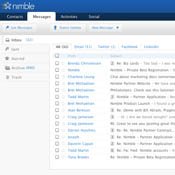Wednesday, April 18, 2012
If you've ever worked in sales, there's a good chance you're familiar with some sort of Customer Relationship Management, or CRM, software. If you haven't had to walk that particular fiery gauntlet, a definition is in order: CRM software essentially enables you to enter contact information for people that you deal with and the businesses you attempt to sell to. You can then track your interaction with those folks—make notes of your calls, emails and drop-ins that you attempt while you're wooing them into your universe—and then you can track the follow-up, service and support issues that you have once you've got them as a client.
Some sales-focused CRM software offers tools like "sales pipelines" to help you make sure you're pursuing enough sales leads and prospects so you can reach your sales goals.
In olden days, these tools were expensive, network-based, enterprise software with names like ACT and Goldmine. By contrast, the latest round of CRM are browser-based "cloud" services that offer low per-month, per-user charges.
Ranked high among them is Highrise (http://www.highrisehq.com) from 37signals, the same folks who bring us the popular Basecamp project-management software. Highrise, like a lot of CRM software, lets you track your clients and potential clients, save notes about them, blind-copy your e-mails to the CRM software (so they're automatically archived with that client profile) and store other notes, and even images or documents such as quotes and proposals. You create "deals" (like "$10,000 design project") that you can then "win" or "lose"—or edit to "$495 design project" once you've come to a realistic agreement with your client.
Why do this? The trick with CRM software is that it can (a) remind you what you've said recently to a client or customer or colleague, (b) help you manage the tasks you set as the next things you need to do for that person and (c) collaborate with others in your office. That means that even if they haven't been dealing with that person, there's a central repository of that information so your folks can follow up intelligently with that client/customer and, hopefully, give them the information they need.
In the JFP sales department, we use a tool called Capsule CRM (http://www.capsulecrm.com) that is similar to Highrise, but geared somewhat specifically to teams of sales people (as opposed to individual creatives). The heart of Capsule is a running list of Recent Activity, which lets me see what the sales reps are doing (and they can see what each other is doing) while putting information about all our clients and "suspects" or "prospects" at our fingertips in real-time.
If someone calls in wanting to place an ad, the sales representative can immediately check the CRM to see if we've talked to this customer before, so the sales rep can pick up where they, or a team member, left off.
But what if you're not in sales? CRM software can be useful for anyone in business, whether it's for managing retail customers (particularly if you track personal preference information, like a consultant, curator or decorator might) or using the latest round of "social CRM" software that helps you track colleagues across their social media profiles.
Nimble (http://www.nimble.com), for instance, is a very creative solution for tracking "people of interest" not just when they e-mail with you directly, but also when they Tweet or post something to Facebook or LinkedIn.
Using the software's "unified Inbox" you can see all sorts of messages—email and social—from the people with whom you're having conversations. And like many of the CRM tools discussed, Nimble will integrate directly with other tools, like e-mail newsletter software MailChimp (mailchimp.com) so that you can get up e-mail newsletters and other interaction with clients or colleagues.
One very impressive tool in this regard is Batchbook (batchblue.com), which is designed to take the "social CRM" concept to a new level. With Batchbook, you can really think of CRM as a shared contacts database for your company or organization, whether or not you're selling things. (I've thought seriously about Batchbook for the JFP's reporters and editors, for instance, so they could see other times a person has been contacted for stories or interviews.)
Batchbook comes complete with the ability to perform "social listening" along with typical email tracking and phone call notes, plus it integrates a to-do list for assigning follow-ups to yourself or co-workers. It also offers the ability to easily create custom Web-based forms for people to request information or sign up for stuff—effectively adding themselves to your CRM database. From there you can follow up, learn more about your contacts and sell them something, offer them a service or just build stronger relationships.
Todd Stauffer is the publisher of the Jackson Free Press. He has authored or co-authored more than 40 technology books.
